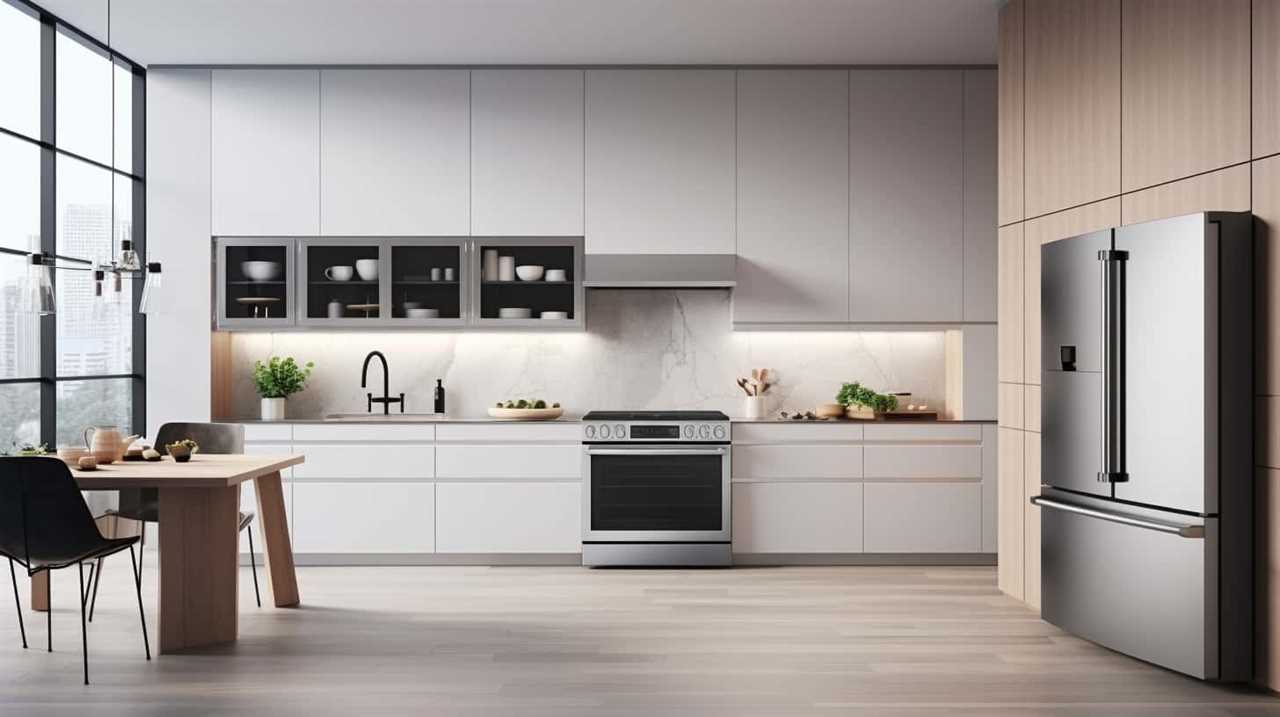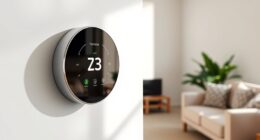The new SEER2, HSPF2, and EER2 test procedures measure HVAC efficiency by simulating real-world conditions more accurately. They incorporate higher static pressures, thermal enclosures, and testing across various temperatures to reflect actual seasonal and peak performance. These updates make the ratings more conservative but reliable for consumers. If you want to understand how these changes affect your chances of saving energy and money, keep exploring the details.
Key Takeaways
- SEER2, HSPF2, and EER2 are updated efficiency metrics reflecting real-world seasonal and peak performance conditions.
- Appendix M1 improves testing accuracy by simulating actual operating environments, including higher static pressure and thermal resistance.
- Tests are conducted across a range of temperatures, including low temps like 5°F, to better reflect cold climate performance.
- The procedures make efficiency ratings more conservative and realistic, often resulting in slightly lower but more reliable values.
- Certification requires re-testing under these protocols, ensuring consumers receive accurate, real-world efficiency information.
Overview of the New Efficiency Metrics in HVAC Industry

The HVAC industry has introduced new efficiency metrics—SEER2, HSPF2, and EER2—that provide a more accurate picture of system performance under real-world conditions. These updated ratings reflect how your system operates during actual seasons, accounting for factors like temperature and humidity. SEER2 measures seasonal cooling efficiency, showing how well your AC removes heat over a typical summer. HSPF2 evaluates heating performance of heat pumps during winter, considering regional climate specifics. EER2 focuses on peak cooling efficiency at high outdoor temperatures, indicating maximum system capacity. The “2” suffix signifies these metrics align with the DOE’s 2023 standards and Appendix M1 test procedures, ensuring they better represent real-world energy use. These new ratings incorporate stricter testing environments, helping you choose more efficient systems, ultimately saving energy and reducing costs. Additionally, understanding the testing standards behind these ratings can further inform your purchasing decisions and ensure you select systems that perform reliably in everyday conditions. Awareness of energy efficiency metrics can help consumers compare systems more effectively and make environmentally conscious choices.
The Role of Appendix M1 in Modern HVAC Testing

Appendix M1 plays a vital role in modern HVAC testing by better simulating real-world conditions, ensuring ratings reflect actual product performance. It increases the external static pressure used during testing, which impacts airflow and energy use measurements. By doing so, it helps you understand how equipment performs under typical installation environments, leading to more accurate efficiency ratings. Incorporating space optimization techniques into testing procedures can further enhance the accuracy of performance assessments. Additionally, considering bedroom design principles can provide insights into optimizing HVAC system placement for comfort and efficiency.
Simulating Real-World Conditions
Simulating real-world conditions is crucial for accurately evaluating the performance of heat pumps and air conditioners, and Appendix M1 plays a pivotal role in this process. It updates testing procedures to better reflect actual operating environments by increasing external static pressure from 0.1-0.2 in. wc. to 0.5 in. wc., and adjusting fan power to typical energy consumption levels. The appendix introduces testing at lower ambient temperatures, including optional 5°F heating tests, and modifies load line slopes for variable-speed units. It also mandates enclosure construction with specified thermal resistance around coils and seals to prevent air leakage. These changes ensure tests mirror real installation conditions, providing more precise efficiency metrics like SEER2, HSPF2, and EER2, closer to actual field performance. Additionally, the revised procedures help in understanding the impact of air leakage and thermal resistance on overall system efficiency. Incorporating testing at various ambient temperatures allows for comprehensive performance evaluation across different climates, further aligning laboratory results with real-world conditions.
Increased Static Pressure Testing
Increased static pressure testing plays a *vital* role in ensuring HVAC equipment performance accurately mirrors real-world conditions. By applying higher external static pressure during testing, you get a more realistic measure of a unit’s fan energy use and efficiency under typical installation scenarios. Appendix M1 mandates specific static pressure levels for different systems, including mobile homes and small-duct, high-velocity setups, ensuring each system is tested under appropriate airflow restrictions. This approach results in generally lower efficiency ratings—SEER2, EER2, and HSPF2—more accurately reflecting actual performance and energy consumption. It also prompts manufacturers to optimize designs for real-world conditions. Incorporating these static pressure levels enhances rating precision across diverse HVAC applications, leading to more reliable performance metrics that help you better predict annual energy use and system efficiency. Additionally, static pressure testing ensures that HVAC systems are evaluated under conditions that closely simulate their operational environments, providing more trustworthy data for consumers and professionals alike. Properly simulating fan energy use during testing is essential for obtaining accurate efficiency ratings and understanding system behavior under typical operating conditions.
How SEER2 Measures Seasonal Cooling Performance

How does SEER2 effectively measure the seasonal cooling performance of air conditioning systems? It calculates the total cooling output over an entire season and divides it by the total electrical energy consumed, providing a thorough efficiency measure. Unlike previous ratings, SEER2 considers a broader temperature range—from about 65°F to 104°F—reflecting real-world conditions. The testing procedure uses higher, more realistic static pressures, making the results more accurate for typical duct systems. By averaging performance across mild, moderate, and hot temperatures, SEER2 offers a better prediction of annual energy costs. This seasonal approach helps consumers understand how systems perform in everyday conditions, leading to more informed decisions and encouraging higher efficiency standards aligned with actual usage. Additionally, understanding system testing procedures can help consumers better interpret these efficiency ratings. Incorporating energy efficiency metrics into purchasing decisions can further optimize long-term savings and environmental impact.
Understanding EER2 and Its Importance During Peak Heat Conditions

During peak heat conditions, EER2 becomes especially important because it measures how efficiently your air conditioning system performs when outdoor temperatures reach around 95°F. Since EER2 is tested at this high outdoor temperature, it provides a realistic view of your unit’s performance during the hottest days. Systems with high EER2 ratings maintain cooling output without excessive energy use, helping you save on utility bills while reducing strain on the power grid. EER2 captures the unit’s efficiency under stress, ensuring you have reliable cooling when temperatures peak. Unlike seasonal metrics like SEER2, EER2 focuses solely on peak conditions, making it an vital indicator for evaluating how well your system handles extreme heat. This rating helps you choose units that perform efficiently during summer’s hottest days. Additionally, understanding the testing procedures for EER2 can help you better interpret the ratings provided by manufacturers.
HSPF2 and Its Significance for Heating Efficiency in Heat Pumps

If you live in a cold climate, understanding HSPF2 helps you choose a heat pump that stays efficient during winter. The M1 testing procedure, introduced with HSPF2, better mirrors real-world conditions, especially in lower temperatures. Higher HSPF2 ratings guarantee your system uses less energy and performs reliably when the cold hits. Embracing renewable energy innovations can also help you develop innovative ways to optimize your heating system’s performance.
Importance in Cold Climates
In cold climates, the efficiency of a heat pump directly impacts your comfort and energy bills, making HSPF2 a critical measure to contemplate. HSPF2 measures how many BTUs of heat a unit produces per watt-hour of electricity over a heating season, including temperatures as low as 35°F. With colder outdoor temperatures, higher HSPF2 ratings mean better heating performance and lower energy consumption. Upgrading from an HSPF of 8 to above 9 can reduce heating costs by 10-15% or more, providing long-term savings. Cold climate heat pumps are designed to operate efficiently at very low temperatures, maintaining capacity and comfort without excessive reliance on backup heat. Choosing a high HSPF2 unit ensures reliable, cost-effective heating during severe winters. Additionally, understanding the contrast ratio helps in selecting heat pumps with better visibility and performance in varying lighting conditions. Proper maintenance of the refrigeration cycle can also help sustain high efficiency levels in cold weather.
Impact of M1 Testing
The M1 testing procedure considerably impacts how heating efficiency is measured for heat pumps by simulating real-world conditions more accurately. It accounts for increased external static pressure, reflecting typical duct resistance, and extends testing to lower temperatures like 5°F. This results in more realistic HSPF2 ratings that better predict seasonal performance. Additionally, integrating sound healing principles can help improve worker focus and reduce stress during testing procedures, leading to more precise results. Sound vibrations are believed to enhance cellular regeneration and overall health, which may also influence the durability and performance of heat pump components under rigorous testing conditions. Key impacts include:
- More accurate efficiency predictions for actual operating conditions.
- Lower HSPF2 ratings by about 10-15%, reflecting added system energy use.
- Stricter testing may challenge product qualification for efficiency programs.
- Manufacturers need to optimize components to meet the revised standards, emphasizing the importance of testing protocols that accurately reflect real-world performance.
Comparing Old Ratings With the New M1-Approved Metrics

Switching from older rating systems like SEER, EER, and HSPF to the new M1-approved metrics can seem complex, but understanding the key differences helps you compare equipment more accurately. The new metrics, SEER2, EER2, and HSPF2, are based on updated DOE test procedures that reflect real-world conditions better. These ratings are generally slightly lower than their predecessors because they use stricter testing standards that account for temperature variations, humidity, and climate differences. While older ratings measured efficiency under more ideal or static conditions, the new ratings present a more realistic picture of how systems perform in everyday use. This shift helps you make better-informed decisions when selecting energy-efficient equipment aligned with current regulations and actual performance. Additionally, AI Security advancements contribute to creating more reliable testing procedures and safety standards for these ratings.
What M1 Testing Means for Manufacturers and Certification

M1 testing standards considerably impact how manufacturers certify their HVAC equipment. You now need to re-test all affected models under the new protocols to generate accurate SEER2, EER2, and HSPF2 ratings. Certification must comply with 10 CFR 429.16 and 429.70 by January 1, 2023, including validation of models using the AEDM method with at least 20% testing and maintaining ±5% accuracy. Full testing of all system combinations is mandatory, ensuring products meet the new standards without exceptions. Understanding the new testing protocols is essential for manufacturers to adapt effectively. Additionally, the integration of advanced testing procedures, such as those influenced by recent AI advancements, can lead to more precise and reliable certification outcomes.
How New Ratings Impact Consumer Choices and Energy Savings

Higher SEER2, HSPF2, and EER2 ratings help you identify more energy-efficient HVAC systems that use less electricity throughout the year, cutting down your utility bills. These updated ratings, based on real-world test procedures, give you more accurate efficiency information, making it easier to estimate savings before buying. Systems with higher ratings run more steadily, with less cycling on and off, which improves energy use and reduces waste. They also lower greenhouse gas emissions by decreasing electricity demand, benefiting the environment. Knowing these ratings encourages you to choose units with top scores to maximize comfort and savings. Additionally, higher-rated systems often qualify for rebates and incentives, making them more cost-effective and appealing investments over the long run. Regulatory standards are increasingly emphasizing the importance of accurate testing procedures to ensure consumer confidence in energy performance data. Incorporating standardized testing methods ensures these ratings truly reflect real-world energy efficiency, providing consumers with trustworthy information.
Future Implications of the Updated HVAC Efficiency Standards

The updated HVAC efficiency standards will considerably influence manufacturer testing and certification processes moving forward. You’ll see stricter testing protocols, accounting for ductwork effects and external static pressure, which lead to about 5% lower SEER2 and EER2 ratings and a 15% drop in HSPF2 ratings—not actual efficiency loss. Manufacturers must redesign and retest roughly 70% of existing units, and labeling must show both old and new ratings during transition. Additionally, the new standards emphasize the importance of measurement accuracy to ensure compliance and reliable performance assessments.
Implications include:
- Higher production costs, increasing unit prices by 15-20%.
- Market phase-out of lower-efficiency models, affecting availability.
- Regional compliance differences, influencing product choices.
- Broader scope of regulations impacting various HVAC components.
Frequently Asked Questions
How Do SEER2, EER2, and HSPF2 Ratings Differ From Their Previous Versions?
You’ll notice SEER2, EER2, and HSPF2 ratings are more accurate and reflect real-world conditions better than their previous versions. They use stricter testing standards, so the numbers are often slightly lower, giving you a realistic idea of energy efficiency. These updates help you compare systems more reliably, especially for peak cooling and heating performance, ensuring you choose equipment that truly meets modern efficiency standards for your climate.
Will New Efficiency Ratings Affect the Cost of HVAC Equipment?
Yes, the new efficiency ratings will likely increase the cost of HVAC equipment. Stricter standards push manufacturers to redesign and improve their units with advanced technologies, which raises production costs. These higher expenses are often passed on to you as a consumer. However, you’ll benefit from better energy efficiency, leading to lower utility bills over time. Incentives and rebates may help offset some of the initial higher purchase prices.
Are Older HVAC Units Impacted by the New M1 Testing Standards?
Yes, your older HVAC units are impacted by the new M1 testing standards. They often score lower on efficiency ratings because M1 accounts for real-world conditions like static pressure and humidity, which older tests didn’t. This means your unit might not meet current efficiency requirements, especially in warmer regions. As a result, it could affect your eligibility for rebates, incentives, and future installations, possibly leading to upgrades or replacements.
How Can Consumers Interpret the Lower Ratings Under the Updated Testing Procedures?
You should see the lower ratings as a more accurate reflection of real-world performance, not a sign of decreased efficiency. These updated tests account for tougher conditions, so ratings like SEER2 or HSPF2 might seem lower but actually prove the equipment works just as well under typical operating conditions. Use these ratings to make smarter choices, knowing they better represent how your system will perform in everyday situations.
What Are the Long-Term Environmental Benefits of Adopting the New Efficiency Metrics?
Adopting these new efficiency metrics is like planting seeds for a greener future. You help cut greenhouse gas emissions by using systems that consume less energy, which supports cleaner air and combats climate change. Over time, your choices reduce reliance on fossil fuels, preserve natural resources, and promote sustainable innovations. This collective effort leads to a healthier planet, ensuring cleaner air and a more stable climate for generations to come.
Conclusion
By understanding SEER2, EER2, and HSPF2 test procedures, you grasp how modern HVAC ratings reflect real-world performance, efficiency, and energy savings. These metrics guide your choices, influence manufacturer standards, and shape future innovations. Embrace the updated standards, compare ratings confidently, and make informed decisions. Because clarity fosters confidence, improvements guarantee efficiency, and awareness empowers your energy-conscious lifestyle. Ultimately, understanding these tests helps you choose smarter, more reliable, and more sustainable HVAC solutions.









